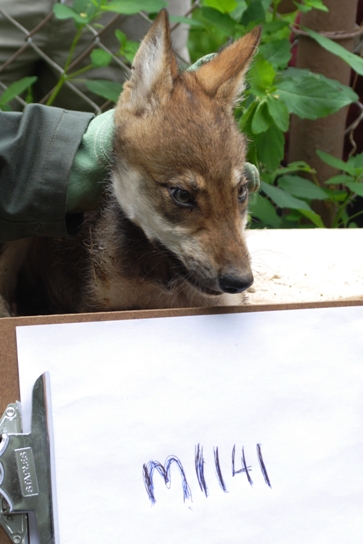03
Dec
Press Release: Mexico Releases Six Mexican Wolves Into the Wild

National Commission of Natural Protected Areas (CONANP)
Wildlife Secretariat of Environment and Natural Resources (SEMARNAT)
For more information: CONANP / DCCC / Branch Information
Tels. 54497000 ext. 17265 or 17220, lidia.huelgas@conanp.gob.mx or dccc@conanp.gob.mx
The National Commission of Natural Protected Areas (CONANP), released in the Sierra Madre Occidental, six Mexican wolves comprised of one female, one male and four cubs. The release has great ecological and symbolic importance of the capacity of the Mexican state of sustainably manage their natural resources and biodiversity.
This process occurs through reintroduction Conservation Program Species at Risk (PROCER), administered by the CONANP, along with sister institution agencies, civil society organizations and academia working in the recovery of this emblematic species.
A individuals released were tracking collars placed them in order to monitor and follow them; also they were vaccinated and transported in cages to the point of liberation, always giving them a dignified and respectful treatment and achieving thereby the shortest possible time in his transfer to the place of release.
They collaborated on this personal process of the Autonomous University of Queretaro, UMA Buenavista del Cobre, as well as delegations from Profepa and Semarnat in the state of Chihuahua.
The authorization for release was conducted by the Directorate General of Wildlife Secretariat of Environment and Natural Resources (SEMARNAT).
The Mexican wolf is a species that has an annual heat in the winter season, so his release not to affect the reproductive process in the released was necessary.
Mexican wolves play an important role in control of species such as coyotes, hares, small rodents and reptiles, as well as their natural food that are deer and peccaries, among others; also allow the vegetation to recover.
The historical distribution of the wolf in Mexico was in the states of Chihuahua, Coahuila, Nuevo Leon, Durango, Zacatecas, Aguascalientes, San Luis Potosi, El Bajio and the Central Plateau, even to Oaxaca.
The conservation program of the Mexican wolf is high on the environmental agenda of the country, which will continue with the recovery effort for this species in the wild, for that research processes for the recovery of the species will be maintained.
The Mexican gray wolf is a subspecies of gray wolf, weight ranging from 21 to 41 kg and measure between 130 and 180 cm snout tail, with the males larger and heavier than females, their fur is yellowish brown, clear in the belly and the inside of the legs, with black and gray shading in the upper dorsal part.
He has a narrow head and big ears, rounded at the ends, with large paws, wide bearings. In the wild live 7 to 8 years in captivity up to 15 years.
The Mexican gray wolf keeps the balance in ecosystems and promote the recovery, maintaining balance of prey populations and promotes the conservation and protection of ecosystems.
The government of the Republic, through the SEMARNAT and CONANP, promotes a series of conservation actions in protected areas through the implementation of subsidy programs, including payment for environmental services and support to community residents , among other actions, to the recovery and conservation of this and other endangered species.
#############################

One of the wolves released was seven-year-old M1141 that was born at the Wolf Conservation Center in New York. You can read more about M1141 and the Wolf Conservation Center here.



